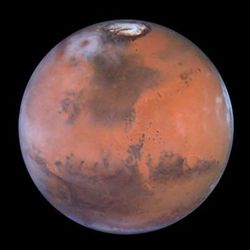But Weather Forecasts Give Scientists A Needed Heads-Up
Heading into a period of the Martian year prone to major dust
storms, the team operating NASA's twin Mars rovers is taking
advantage of eye-in-the-sky weather reports.

On April 21, Mars will be at the closest point to the sun in the
planet's 23-month, elliptical orbit. One month later, the planet's
equinox will mark the start of summer in Mars' southern hemisphere.
This atmospheric-warming combination makes the coming weeks the
most likely time of the Martian year for dust storms severe enough
to minimize activities of the rovers.
"Since the rovers are solar powered, the dust in the atmosphere
is extremely important to us," said Bill Nelson of NASA's Jet
Propulsion Laboratory, Pasadena, CA, chief of the engineering team
for Spirit and Opportunity.
Unexplained computer reboots by Spirit in the past
week are not related to dust's effects on the rover's
power supply, but the dust-storm season remains a concern. Spirit
received commands Tuesday to transmit more engineering data in
coming days to aid in diagnosis of the reboots.
After months of relatively clear air, increased haze in March
reduced Spirit's daily energy supply by about 20 percent and
Opportunity's by about 30 percent. Widespread haze resulted from a
regional storm that made skies far south of the rovers very dusty.
Conditions at the rovers' sites remained much milder than the worst
they have endured. In July 2007, nearly one Martian year ago,
airborne dust blocked more than 99 percent of the direct sunlight
at each rover's site.
 The rovers point cameras toward the
sun to check the clarity of the atmosphere virtually every day.
These measurements let the planning team estimate how much energy
the rovers will have available on the following day. Observations
of changes in the Martian atmosphere by NASA's Mars Reconnaissance
Orbiter, which reached Mars in 2006, and NASA's Mars Odyssey, which
reached Mars in 2001, are available to supplement the rover's own
skywatch.
The rovers point cameras toward the
sun to check the clarity of the atmosphere virtually every day.
These measurements let the planning team estimate how much energy
the rovers will have available on the following day. Observations
of changes in the Martian atmosphere by NASA's Mars Reconnaissance
Orbiter, which reached Mars in 2006, and NASA's Mars Odyssey, which
reached Mars in 2001, are available to supplement the rover's own
skywatch.
The Mars Color Imager camera on Mars Reconnaissance Orbiter sees
the entire planet every day at resolution comparable to weather
satellites around Earth. Two other instruments -- the Thermal
Emission Imaging System on Mars Odyssey and the Mars Climate
Sounder on Mars Reconnaissance Orbiter -- monitor changes in
airborne dust or dust-related temperatures in Mars' upper
atmosphere. Orbiters also aid surface missions with radio relays,
imaging to aid drive plans, and studies of possible future landing
sites.
When orbital observations indicate a dust-raising storm is
approaching a rover, the rover team can take steps to conserve
energy. For example, the team can reduce the length of time the
rover will be active or can shorten or delete some communication
events.
In recent weeks, frequent weather reports from Bruce Cantor of
Malin's Mars Color Imager team let the rover team know that the
March increase in haziness was not the front edge of a bad storm.
At other times, the weather reports prompt quick precautionary
actions. On Saturday, November 8, 2008, the rover team received
word from Cantor of a dust storm nearing Spirit. The team deleted a
communication session that Sunday and sent a minimal-activity set
of commands that Monday. Without those responses, Spirit would
likely have depleted its batteries to a dangerous level.
Winds that can lift dust into the air can also blow dust off the
rovers' solar panels. The five-year-old rover missions, originally
planned to last for three months, would have ended long ago if
beneficial winds didn't occasionally remove some of the dust that
accumulates on the panels. A cleaning event in early April aided
Opportunity's power output, and Spirit got two minor cleanings in
February, but the last major cleaning for Spirit was nearly a full
Martian year ago.
Nelson said, "We're all hoping we'll get another good
cleaning."
 ANN's Daily Aero-Term (05.05.24): Omnidirectional Approach Lighting System
ANN's Daily Aero-Term (05.05.24): Omnidirectional Approach Lighting System Aero-News: Quote of the Day (05.05.24)
Aero-News: Quote of the Day (05.05.24) Airborne 05.06.24: Gone West-Dick Rutan, ICON BK Update, SpaceX EVA Suit
Airborne 05.06.24: Gone West-Dick Rutan, ICON BK Update, SpaceX EVA Suit Airborne 05.03.24: Advanced Powerplant Solutions, PRA Runway Woes, Drone Racing
Airborne 05.03.24: Advanced Powerplant Solutions, PRA Runway Woes, Drone Racing Aero-News: Quote of the Day (05.06xx.24)
Aero-News: Quote of the Day (05.06xx.24)




